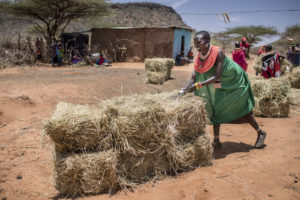Conflicts and weather patterns strain food security around the globe
On 5 March 2018 the Trade and Markets Division of FAO issued the Crop Prospects and Food Situation report. According to the report, some 37 countries are in need of external assistance for food, unchanged from three months ago.
On 5 March 2018 the Trade and Markets Division of FAO issued the Crop Prospects and Food Situation report. According to the report, some 37 countries are in need of external assistance for food, unchanged from three months ago. High levels of food insecurity persist in the world, due largely to conflicts and to adverse climatic shocks that are taking a toll, particularly in East African and Near East countries, where large numbers of people continue to be in need of humanitarian assistance, a new FAO report notes.
Civil war and insecurity are direct reasons for high hunger rates in 16 of those countries, ranging from Burundi to Yemen. Conflict is displacing millions of people, hampering agricultural activities and, in many cases, also driving basic food prices up sharply, the report notes. Inflation in the Democratic Republic of Congo more than doubled in 2017 to a 42 percent annual rate. Violence has disrupted traditional trade routes around the Sahel, driving up prices, while food shortages are reported around southern and eastern Libya.
Meanwhile, inadequate and erratic rainfall poses a growing threat to food security in Southern Africa as well as in Eastern Africa, where many rural households have suffered from four consecutive drought-affected agricultural seasons.
Dry weather impacts East Africa
The overall cereal output rebounded in Africa in 2017, mostly due to strong gains in Southern Africa following the sharply reduced harvest in 2016. Cereal production in East Africa, however, saw a 7.2 percent drop, leading to increased stress in various countries. Recently-concluded harvests of secondary season cereal crops are forecast to be below average in southeastern Kenya, northeastern Tanzania and southern Somalia, the report warns.
Aggregate cereal production from Somalia‘s “deyr” rainy season is estimated to be 20 percent below average as seasonal rains had a late start and an early cessation. A similar pattern in rainfall and yields was observed in northeastern Tanzania. South Sudan’s cereal output from the 2017 planting seasons is estimated to be the smallest since the conflict started at the end of 2013.
 Drought conditions in parts of Ethiopia and Somalia have eased, but not enough to fully offset accumulated deficits in soil moisture. Pasture availability is still below average and livestock body conditions are generally poor. In Kenya, seasonal rainfall was up to 80 percent below average levels, warranting close monitoring of rangeland conditions in eastern areas of the country.
Drought conditions in parts of Ethiopia and Somalia have eased, but not enough to fully offset accumulated deficits in soil moisture. Pasture availability is still below average and livestock body conditions are generally poor. In Kenya, seasonal rainfall was up to 80 percent below average levels, warranting close monitoring of rangeland conditions in eastern areas of the country.
Prices of staple cereals are also high in Ethiopia and the Sudan, where retail prices of sorghum, millet and wheat have doubled since last October in the majority of local markets. The price jump was triggered by the removal of government wheat subsidies, which increased demand for substitute cereals, and by weakening currencies.
Unfavourable seasonal rains in southern Madagascar are expected to result in a further drop in crop yields in 2018, which, coupled with historically high prices of rice, should put additional stress to food security conditions especially in southern areas. Elsewhere, in Southern Africa, production is expected to fall from the record highs of 2017, heightening concerns about food security, which FAO flagged in a Special Alert issued last week.
The 37 countries (30 are members of the SUN Movement) currently in need of external food assistance are Afghanistan, Burkina Faso, Burundi, Cameroon, Central African Republic, Chad, Congo, Democratic People’s Republic of Korea, Democratic Republic of the Congo, Djibouti, Eritrea, Ethiopia, Guinea, Haiti, Iraq, Kenya, Lesotho, Liberia, Libya, Madagascar, Malawi, Mali, Mauritania, Mozambique, Myanmar, Niger, Nigeria, Pakistan, Sierra Leone, Somalia, South Sudan, Sudan, Swaziland, Syria, Uganda, Yemen and Zimbabwe.
Related Information
• Crop Prospects and Food Situation Report – March 2018: English
• Crop Prospects and Food Situation Report – Previous Editions
• FAO News release
